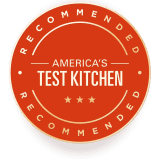All-Purpose Spray Cleaners
Equipment Review
Humans have been washing dishes for centuries. Are innovations in dish soap making the job any easier?
Published Apr. 1, 2014. Appears in Cook's Country TV Season 8: Break Out the Bourbon
As much as we love our dishwashers, when washing delicate china, wood cutting boards, sharp knives, and pots and pans, we still rely on soap and sponge. The last time we tested dish soaps, in 2007, we liked Method Go Naked Ultra Concentrated Dish Detergent best. But it was recently discontinued, so we are revisiting the subject.
We were surprised to find a host of new soaps designed for people who scrub dishes under a running tap rather than fill the sink with soapy water—the more traditional method. So we decided to include three such products: two with pumps that foam straight from the bottle, and one with a special motion-sensor system for germ-free dispensing. We also found an unusual dishwasher detergent/dish soap hybrid. Four of the seven products also make some claim to being environmentally friendly, so we pitted them against the benchmark for traditional liquid soaps—the national best seller Dawn Ultra.
In the kitchen, we gleefully made a mess, burning skillets with measured portions of hard-to-clean foods like béchamel sauce and chicken teriyaki. Controlling for the amount of soap, water temperature, and type of sponge, we washed the pans using both the fill-sink method and the rinse method, counting the strokes needed to get each pan clean. Our best soaps required fewer than 70 strokes, while others needed anywhere from 85 to 100. One soap consistently required more than 100 strokes and even then left a film of oil. What accounted for these differences?
Oil and water repel each other, so soap makes washing dishes easier because it contains surfactants, tadpole-shaped chemicals with water-loving heads and oil-loving tails that encourage water and fat to mix. Surfactants can be made from plants (for all-natural cleaners) or petroleum, but according to Brian Grady, director of the Institute of Applied Surfactant Research at the University of Oklahoma, the origin of surfactants doesn’t determine the effectiveness of the soap. “There’s no inherent advantage of one over the other,” he said. “It comes down to the individual formula and overall quantity of surfactants.”
We turned to a simple science project to measure the power of each product. Surfactants make water “wetter” by lowering its surface tension, allowing tightly packed water molecules to spread out and make room for dirt and grease. We mixed a measured solution of soap and water in plastic cups and suspended a strip of paper bag so that it was just touching the surface. A solution with strong surfactants (and therefore lower surface tension) will allow the water to climb the strip of paper; the higher it travels the stronger the surfactants.
After an hour, the...

The mission of America’s Test Kitchen Reviews is to find the best equipment and ingredients for the home cook through rigorous, hands-on testing. We stand behind our winners so much that we even put our seal of approval on them.

This is a members' feature.